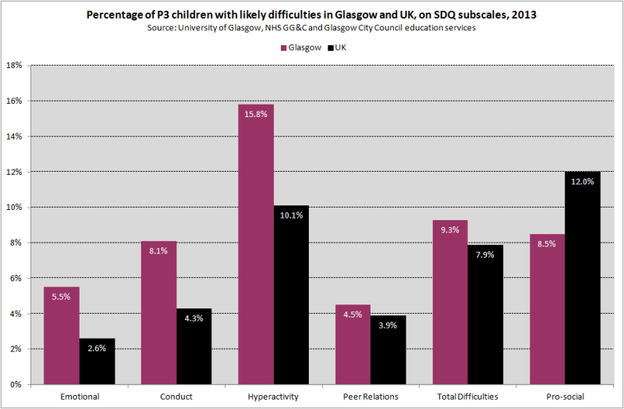Comparison to UK
Fewer than 1 in 10 children in P3 in Glasgow City had social, emotional or behavioural difficulties on the Total Difficulties scale (9.3%). The highest proportion of difficulties was with hyperactivity/inattention, where 15.8% of P3s in Glasgow City had difficulties in this area. This was substantially higher than the levels of hyperactivity/inattention difficulties in the UK as a whole for 5-10 year olds(Green et al. 2005). This may be related to the higher levels of deprivation in Glasgow City, which may exacerbate such difficulties. Children in P3 in Glasgow City were also twice as likely to have difficulties with their behaviour (8.1% vs.4.3%), but they were less likely to have difficulties with pro-social behaviours, such as volunteering to help others or being kind.
Notes
SDQ - Goodman’ Strengths and Difficulties Questionnaire (SDQ) is a brief behavioural screening questionnaire for children. It covers five areas: Conduct Problems, Hyperactivity/inattention, Peer Relationship Problems, Emotional Symptoms and Pro-social Behaviours. The first four of these are rated negatively (that is, they pick up difficulties in children). These can be added together to give a Total Difficulties score, which shows an indication of overall difficulties that the child is experiencing. The final area, Pro-social Behaviours, is a positively scored scale, so it shows things the child does e.g. ‘is helpful if someone is hurt or upset’. The Total Difficulties score and the sub-scale scores can be split into groups which indicate whether a child has no difficulties, possible difficulties or likely difficulties.
This analysis reports on results from Primary 3 SDQs in the academic years 2011/12 and 2012/13 combined (data collected in February/March of each academic year). For more information on the study see About the Study.







